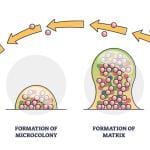Mastication, commonly known as chewing, is a fundamental physiological process involved in the breakdown of food into smaller, more manageable particles. This process initiates digestion, making it easier for the body to extract essential nutrients from the ingested food. Mastication is a complex and coordinated action involving various muscles, nerves, and biological factors. In this article, we delve into the intricate details of mastication, exploring its mechanics, significance, and the factors that influence this essential process.
The Anatomy of Mastication
- Masticatory Muscles
- Temporomandibular Joint (TMJ)
Masticatory Muscles
Mastication primarily involves the action of three groups of muscles: the muscles of mastication, the tongue muscles, and the muscles of the lips and cheeks. The muscles of mastication include the masseter, temporalis, medial pterygoid, and lateral pterygoid muscles. These muscles work in harmony to facilitate the chewing process.
- Masseter Muscle
- Temporalis Muscle
- Medial Pterygoid Muscle
- Lateral Pterygoid Muscle
Masseter Muscle
Located in the cheek area, the masseter muscle is the strongest and most prominent masticatory muscle. It aids in elevating the mandible (lower jaw) during closing of the mouth.
Temporalis Muscle
Situated on the sides of the skull, the temporalis muscle helps in elevating and retracting the mandible.
Medial Pterygoid Muscle
This muscle assists in elevating the mandible and moving it from side to side during chewing.
Lateral Pterygoid Muscle
The lateral pterygoid muscle is responsible for lowering the mandible and moving it forward and side to side.
Temporomandibular Joint (TMJ)
The temporomandibular joint connects the jawbone (mandible) to the skull. It is a crucial component in mastication, enabling the smooth movement of the jaw during chewing. Any issues with the TMJ can lead to difficulties in chewing and discomfort.
The Mechanics of Mastication
The process of mastication involves a series of coordinated movements that effectively break down food into smaller particles, making it easier for further digestion. These movements can be broken down into several phases:
- Ingestion and Preparatory Phase
- Compression and Fragmentation
- Mixing and Saliva Incorporation
- Bolus Formation
Ingestion and Preparatory Phase
The mastication process begins with the placement of food in the mouth. The tongue helps position the food between the teeth for optimal chewing. Saliva is introduced during this phase, helping to moisten and soften the food, making it more amenable to chewing.
Compression and Fragmentation
Once the food is properly positioned, the teeth come into play. The upper and lower teeth work together to compress and fragment the food into smaller, manageable pieces. The powerful masticatory muscles exert force to facilitate this breakdown process.
Mixing and Saliva Incorporation
As the food is chewed, it mixes with saliva, forming a bolus that is easier to swallow. Saliva also contains enzymes like amylase, which begins the process of breaking down carbohydrates.
Bolus Formation
The chewed food and saliva form a cohesive mass known as a bolus. The tongue helps in shaping and manipulating the bolus for efficient swallowing.
The Role of Saliva in Mastication
Saliva is a critical component of the mastication process. It serves multiple essential functions during chewing, including:
- Moistening
- Lubrication
- Initiating Digestion
- Bolus Formation
Moistening
Saliva moistens food, making it easier to chew and swallow.
Lubrication
It provides lubrication for the food particles, aiding in smooth movement during mastication.
Initiating Digestion
Saliva contains enzymes, such as amylase, which start the digestion of starches.
Bolus Formation
Saliva helps in binding food particles together to form a bolus, facilitating easy swallowing.
The Sensory Feedback in Mastication
Mastication involves a feedback loop between the mouth, brain, and other sensory organs, ensuring that the process is efficient and safe. Several types of sensory receptors play a role:
- Mechanical Receptors
- Taste Receptors
- Thermal and Pain Receptors
Mechanical Receptors
These receptors, located in the temporomandibular joint, oral mucosa, and periodontal ligaments, provide feedback on the pressure and position of the food during chewing. This information helps regulate the force exerted by the masticatory muscles.
Taste Receptors
Taste buds in the tongue and other parts of the oral cavity allow us to perceive the taste of food, influencing our chewing patterns and food preferences.
Thermal and Pain Receptors
Receptors sensitive to temperature and pain play a vital role in preventing us from consuming food that may be too hot or causing discomfort during mastication.
Factors Affecting Mastication
Several factors influence the mastication process, including age, dental health, diet, and overall health:
- Age
- Dental Health
- Dietary Composition
- Oral Health Issues
Age
Masticatory efficiency tends to decline with age due to changes in tooth structure, muscle strength, and the overall health of the oral cavity.
Dental Health
The presence of healthy teeth and well-functioning dental prosthetics significantly impacts mastication efficiency. Tooth decay, missing teeth, or ill-fitting dentures can hinder the chewing process.
Dietary Composition
The type and texture of food can affect mastication. Foods that are harder or require more chewing can enhance masticatory muscle strength and function.
Oral Health Issues
Conditions like temporomandibular joint disorders, malocclusions, or oral infections can impair the mastication process.
The Significance of Efficient Mastication
Efficient mastication is crucial for overall health and well-being. It ensures that food is adequately broken down, allowing for better digestion and absorption of nutrients. Properly chewed food reduces the burden on the digestive system and helps prevent issues like indigestion and gastrointestinal discomfort.
Moreover, effective mastication contributes to better oral health. Chewing stimulates saliva production, which aids in maintaining oral hygiene by neutralizing acids, remineralizing teeth, and preventing dental decay.
Disorders and Conditions Affecting Mastication
Several disorders and conditions can impact the process of mastication, leading to difficulties in chewing and potentially affecting overall health. Some notable disorders include:
- Temporomandibular Joint Disorders (TMD)
- Malocclusions
- Bruxism
- Oral Cancer
Temporomandibular Joint Disorders (TMD)
TMD refers to a group of conditions that affect the temporomandibular joint and the surrounding muscles, causing pain, difficulty in jaw movement, and challenges in mastication. Common symptoms include jaw pain, clicking or popping sounds during jaw movement, and difficulty opening or closing the mouth.
Malocclusions
Malocclusions are misalignments in the teeth or jaw, affecting how the upper and lower teeth fit together. This misalignment can result in challenges in chewing and may require orthodontic treatment for occlusion correction.
Bruxism
Bruxism is the habit of clenching or grinding the teeth, often involuntarily during sleep. Over time, this can lead to worn-down teeth, jaw pain, and muscle fatigue, affecting the efficiency of mastication.
Oral Cancer
Oral cancers, affecting the mouth and throat, can disrupt mastication due to pain, difficulty in swallowing, and the need for surgical interventions that alter the anatomy of the oral cavity.
Rehabilitation and Therapies for Mastication Disorders
Efficient mastication is essential for overall health and quality of life. When mastication is impaired due to disorders or conditions, rehabilitation and therapies become vital for improving the chewing process. Some rehabilitation strategies include:
- Physical Therapy
- Orthodontic Treatment
- Dietary Modifications
- Prosthetic Solutions
Physical Therapy
Physical therapy can help manage temporomandibular joint disorders and muscle-related issues. It involves exercises, stretches, and massage techniques to improve jaw movement and muscle function.
Orthodontic Treatment
Orthodontic interventions like braces, aligners, or other orthodontic appliances can correct malocclusions and misalignments, enhancing masticatory efficiency.
Dietary Modifications
For individuals with difficulty chewing, modifying the diet to include softer foods, purees, or well-cooked options can make it easier to consume essential nutrients.
Prosthetic Solutions
Dentures, dental implants, or bridges can replace missing teeth, restoring the ability to chew effectively and improving overall masticatory function.
Future Perspectives and Research
The field of mastication research is continuously evolving, driven by advancements in various scientific domains. Future research may focus on:
- Biomechanics of Mastication
- Mastication and Cognitive Function
- Technological Innovations
Biomechanics of Mastication
A deeper understanding of the biomechanics involved in chewing, including muscle coordination, force distribution, and joint movement, could lead to innovative solutions for mastication-related issues.
Mastication and Cognitive Function
Exploring the connection between mastication, chewing efficiency, and cognitive function could shed light on how chewing impacts brain health, especially in aging populations.
Technological Innovations
Advancements in dental technology and prosthetics may lead to more efficient and comfortable solutions for individuals with mastication difficulties.
Conclusion
Mastication, a seemingly mundane activity, holds immense importance in our daily lives and overall health. From the intricate muscular movements to the sensory feedback that guides the process, mastication is a remarkable blend of biology and biomechanics. Understanding its mechanics, the role of saliva, and the factors influencing mastication enables us to appreciate its significance in digestion and oral health. Moreover, acknowledging disorders affecting mastication and exploring rehabilitation methods ensures that individuals facing challenges in chewing can receive the necessary support to improve their quality of life. As research continues to unravel the complexities of mastication, we can look forward to innovative solutions that further optimize this fundamental physiological process.






pharmacy
23 October 2023whoah this blog is wonderful i love studying your articles. Keep up the good work! You recognize, many people are looking round for this info, you can help them greatly.